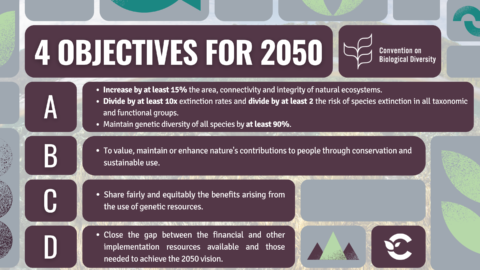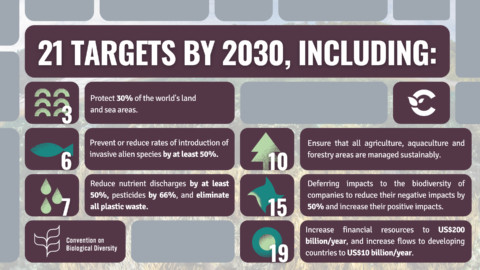The signing of the agreement for a new international framework on biodiversity for 2020-2050 has been pending since 2020. Will the meeting of the parties scheduled for December in Montreal for the COP15 meet the expectations of the stakeholders?
The COP15 of the Convention on Biological Diversity (CBD) is the 15th meeting of the parties to the Convention. Its governing body, which is composed of all the signatories governments to the Convention (currently 196) normally meeting every 2 years. The CBD has three main objectives: the conservation of biological diversity, the sustainable use of biological diversity, and the fair and equitable sharing of the benefits arising out of the utilisation of genetic resources.
The 2022 edition should allow parties to agree on a framework for international commitment to biodiversity post-2020, with a milestone of 2030 and a final target of 2050.To follow the latest updates about the COP15, you can visit the official website of the CBD.
The reasons for the erosion of biodiversity are known, as are the changes needed to stop this erosion (control of consumption, changes in production methods, etc.) [1]. The economic and political stakes of these changes are all the more complex as the transformations required are fundamental – even more radical than those required to mitigate and adapt to climate change.
After the failure of the Aichi targets [2] and the CBD’s difficulties in organizing the COP15, the challenge for the negotiators is to succeed in aligning ambition, monitoring indicators, and financial means.
The issues at stake: protected areas, reduction of pressures on biodiversity, reporting, financing, etc.
The Parties are currently negotiating a text detailing the means to achieve “living in harmony with nature by 2050”, which is the vision of the CBD.
The text includes four 2050 Goals, articulated in Milestones, and 21 shorter-term 2030 Action Targets – which are of particular interest.

One of the first topics is conservation, and therefore the surfaces covered by protected areas. Target 3 aims to protect 30% of the world’s land and 30% of its oceans by 2030, while only 17% of the land surface and 7% of the marine and coastal areas were protected in 2020 (CBD 2020a see note [2]). How these protected areas will be distributed among the Parties and with what protection is an eminently thorny question, given the variability of conservation issues according to the areas, the financing needs, national, regional, and international policies, etc.
The ambition to “live in harmony with nature” cannot be summed up by simply increasing the number of protected areas, which is not sufficient to halt the loss of biodiversity. The reduction of direct and indirect pressures is also key, and this is driven by both states and private actors. Although the discussions do not focus much on the objectives to be set at the level of companies/sectors of activity, it is undeniable that their commitment is necessary to achieve the objectives that will be voted on – they are moreover directly concerned with several Targets.
These include the following Targets – which have been a particular source of tension in the negotiations:
- Target 6: Reduce the rate of introduction of invasive species by at least 50%; Target 7: reduce nutrient pollution, especially nitrogen pollution, by at least 50%; pesticides by at least 66%.
- Target 7: Reduce nutrient pollution, especially nitrogen, by at least 50%; pesticides by at least 66%; eliminate plastic waste
- Target 10: Sustainably manage agricultural, forestry, and aquaculture areas (no more specific quantitative targets are given)
- Target 15: Analyze and report on the impacts and dependencies of businesses on biodiversity, across their value chain, and reduce negative impacts by at least 50%, increase positive impacts
The financing of this framework is a matter of debate between the Parties (see Target 19): it is now established that there is a shortfall of around 700 billion dollars in annual financing to achieve the objectives of “living in harmony with nature” [3]. Among the levers identified and under debate is the reduction of funding for activities that are harmful to nature, the mobilization of the private sector in the financing of this framework, and subsidies between Parties.

Will the CBD COP15 be the equivalent of the COP21 for biodiversity?
Will it succeed in involving non-state organizations and their contributions (including companies and financial actors)? Will it be a moment of citizen mobilization, widely reported in the international press? Will the parties succeed in agreeing on a clear quantitative objective to limit the erosion of global biodiversity and the means to achieve it?
This COP15 is mobilizing private actors, who, under the media attention on the subject, are taking the opportunity to make commitments. The dynamism of the Business for Nature coalition, created in 2019, is a source of hope. It manages to get 330 companies and financial institutions to agree with a good number of multinationals with significant impacts on biodiversity (Carrefour, Google, Iberdrola, LafargeHolcim, etc.) as well as experts such as I Care, around the Target 15 to “make mandatory the assessment and disclosure of risks and impacts to nature”, an initiative propelled by the petition and the #MakeItMandatory campaign.
There is still a long way to go before countries, private actors and organizations widely concretize science-based, quantified, and time-demanding ambitions to constrain economic activities and our lifestyles in order to “live in harmony with nature” as suggested in the text under debate today.
If the expectations of civil society and some countries are strong, the difficulties encountered by the negotiators to advance the text and integrate concrete commitments are indicative of the strong international tensions. Many unknowns still remain about the real ambitions of the text that will be voted on.
A quantitative goal on the horizon?
There remains the issue of the commitment to a quantitative target for limiting biodiversity loss. The desired horizon is clearly stated: “to put biodiversity on a path to recovery by 2030”, but its translation into measurable objectives for governments and economic actors is far from clear.
I Care is an active player in the development of these indicators at different scales by promoting all the research work carried out over the last 10 years on the state of biodiversity and the impacts of economic activities on biodiversity. With Iceberg Data Lab and CDC Biodiversity, I Care supports in particular the MSA and km².MSA metrics as relevant indicators for Goal A and Target 15 [4] (see here to become a co-signatory of the position paper).
Beyond the indicators, it is essential to offer economic actors international evaluation and commitment frameworks adapted to companies, which will allow each actor to accelerate and deepen the evaluation of its business model with regard to the impacts on the erosion of living organisms and the underlying risks. The frameworks proposed by SBTN, TNFD, or ACT4Nature are useful to trigger this dynamic of economic actors, which is complementary to the efforts of the COP15. These initiatives are logically waiting for an international consensus on the “global objective of recovery” so that it can be applied to companies and financial institutions, as was the case with the Paris Agreement on climate change.
References
- [1] A report is being prepared by IPBES on the transformative changes needed to live in harmony with nature by 2050.
- [2] A CBD report shows that none of the 20 targets have been fully met, and only 6 have been partially met (CBD 2020a).
- [3] Deutz, et. al. 2020. Financing Nature: Closing the global biodiversity financing gap. The Paulson Institute, The Nature Conservancy, and the Cornell Atkinson Center for Sustainability.
- [4] The link of the positioning note and its annex
- Go further: Outcomes of the work of the Informal Group on the Post-2020 – 17th October 2022
“Insight” is our series of publications designed to help you better understand today’s important events. Other Insight publications are available here.






